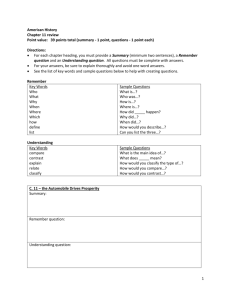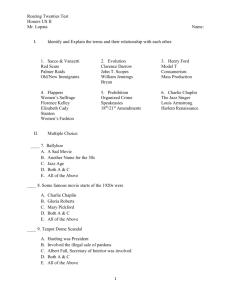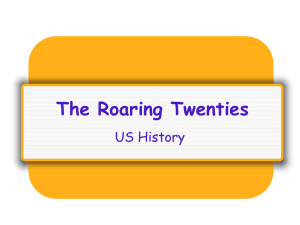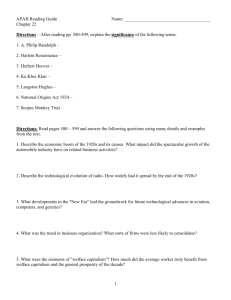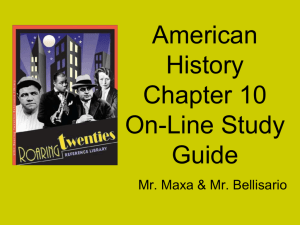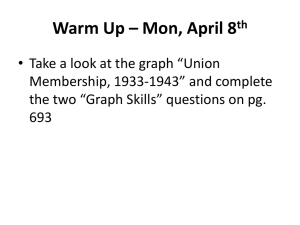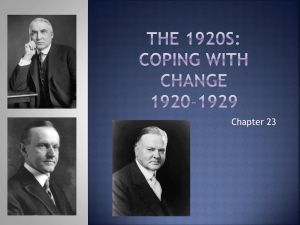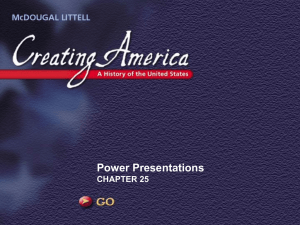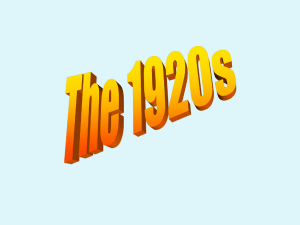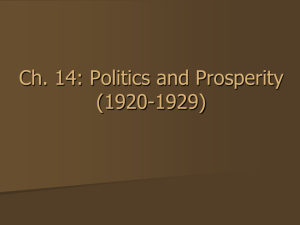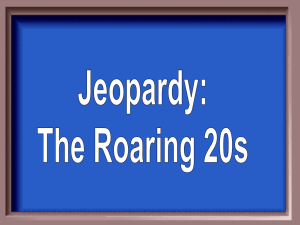File
advertisement
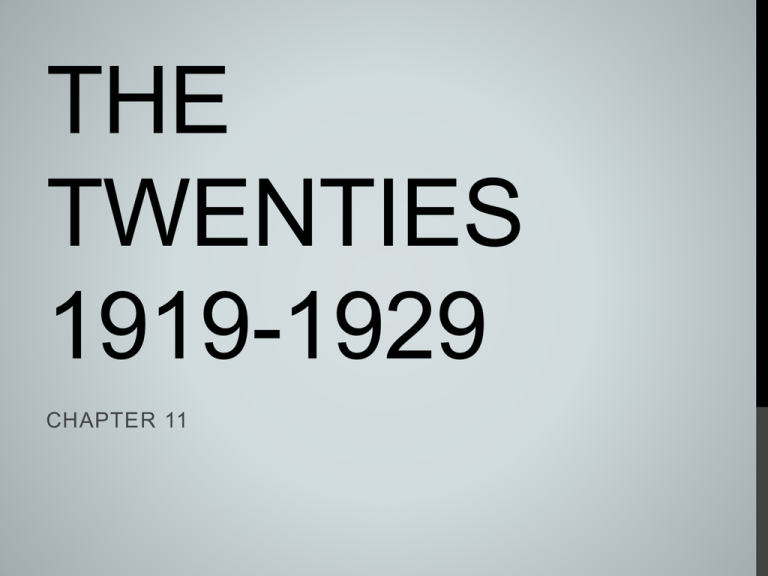
THE TWENTIES 1919-1929 CHAPTER 11 SECTION 1 A BOOMING ECONOMY THE AUTOMOBILE DRIVES PROSPERITY The US enjoyed an economic boom in the 1920s. Much of the growth came from the automobile industry. Henry Ford – introduced a series of methods and ideas that revolutionized production, wages, working conditions, and daily life. FORD PIONEERS MASS PRODUCTION Mass Production – the rapid manufacture of large numbers of identical products. Model T – a reliable car the average American could afford FORD PIONEERS MASS PRODUCTION CONT. Scientific Management – experts to improve Ford’s mass-production techniques Assembly Lines – a worker added something to construct the automobile The assembly line allowed Ford to continue to drop the sale price of his cars Model T $350 1916 $290 1927 FORD PIONEERS MASS PRODUCTION CONT. In 1914 Henry Ford more than doubled the wages of a large number of his workers, from $2.35 to $5.00 a day, with Saturday and Sunday off. Ford became very rich and also one of the shapers of the modern world. THE AUTOMOBILE CHANGES AMERICA The boom in the automotive industry stimulated growth in other industries related to manufacturing or use. Road construction boomed, people had a sense of freedom and prosperity, and altered residential patterns. A BUSTLING ECONOMY Consumer Revolution – a flood of new, affordable goods became available to the public Electrical power helped to support this revolution, washing machines, vacuums, irons, radio, and refrigerator ADVERTISING AND CREDIT BUILD A CONSUMER CULTURE Advertising in magazines and newspaper ads became more common, they focused on the desires and fears of Americans rather than what was needed. ADVERTISING AND CREDIT BUILD A CONSUMER CULTURE CONT. Installment Buying – in which a consumer would make a small down payment and then pay off the rest in monthly payments This allowed many Americans to own things they would have had to save for years to buy THE BIG BULL MARKET MAKES FORTUNES Bull Market – a period of rising stock prices Buying on Margin – another form of buying on credit (stocks) Get Rich quick mentality! CITIES, SUBURBS, AND COUNTRY The economic boom did not affect all parts of the nation equally. While urban and suburban areas prospered, rural Americans faced hardships. PEOPLE FLOCK TO CITIES Immigrants and Farmers flocked towards the cities Northern cities were their destination Empire State Building symbolized the power and majesty of the United States THE SUBURBS GROW Improved mass transportation and the use of automobiles caused cites to expand outward SECTION 1 A BOOMING ECONOMY How did the booming economy of the 1920s led to changes in American life? How did Henry Ford increase the production and sale of automobiles? How did buying on margin allow more people to invest in the stock market? What impact did the development of suburbs have on American society? SECTION 2 THE BUSINESS OF GOVERNMENT President Harding: “Return to Normalcy,” Rather then reform Harding and his successor, Calvin Coolidge, favored more conservative policies that aided business growth. A more laissez-faire approach. THE HARDING ADMINISTRATION NEW POLICIES FAVOR BIG BUSINESS Andrew Mellon – wealthy banker appointed Secretary of the Treasury by Harding He supported legislation that advanced business (low taxes on individuals and corporations) NEW POLICIES FAVOR BIG BUSINESS Harding raised protective tariff by 25%, while European nations also raised tariffs Herbert Hoover – Secretary of Commerce worked with business leaders to achieve voluntary advancements for industry (progressives used legislation while Hoover got people to work together) THE OHIO GANG CASHES IN The Ohio Gang were close friends to Harding that were not honest public servants. They saw government service as a chance to get rich. (100 years worth of floor cleaner) pg. 331 THE TEAPOT DOME SCANDAL EXPLODES Teapot Dome Scandal – Secretary of the Interior arranged for the transfer of oil reserves intended for the Navy to other locations and leased those properties to private oilmen in return for loans COOLIDGE PROSPERITY Calvin Coolidge – Vice President when Harding died his father a justice of the peace, used the family Bible to swear in his son as President SILENT CAL SUPPORTS BIG BUSINESS Coolidge was for productive businesses and once stated “The man who builds a factory, builds a temple” He continued to reduce the national debt, and trimmed the federal budget This gave a great boom for the national economy TROUBLES BREW BENEATH THE SURFACE During this time Farmers struggled to keep their land and unions demanded higher wages, Jim Crow laws were in play and Mexican Americans faced shamefully low wages. “Silent Cal,” remained silent, he mistrusted the use of legislation to achieve social change AMERICA’S ROLE IN THE WORLD The U.S. continued to play an important role in world business and trade. Foreign policy was shaped by what happened in WWI. SEEKING AN END TO WAR Washington Naval Disarmament Conference – set out to limit naval build-up and solve disagreements without resorting to war Kellogg-Briand Pact – 1928, this set to “outlaw war” and agreed to by 62 nations but soon was unenforceable COLLECTING WAR DEBTS U.S. insisted that Britain and France repay their war debts for that to happen Germany had to make reparations to them Dawes Plan – arranged U.S. Loans to Germany HUH???? SECTION 2 THE BUSINESS OF GOVERNMENT How did domestic and foreign policy change direction under Harding and Coolidge? What were the causes and effects of the Teapot Dome scandal? What policies did Calvin Coolidge favor to support economic growth? How did the United States support world peace efforts during the 1920’s? SECTION 3 SOCIAL AND CULTURAL TENSIONS TRADITIONALISM AND MODERNISM CLASH America became split not by north-south or east-west but by urban and rural regions Modernism – emphasize science and secular values over traditional ideas about religion Rural populations generally embraced a more traditional view of religion, science, and culture EDUCATION BECOMES MORE IMPORTANT Rural views differed from urban on the topic of education. Rural communities saw value in the “Three R’s” ( reading, writing, and arithmetic). Urban America saw mental ability, not muscular fitness as essential for success. RELIGIOUS FUNDAMENTALISM GROWS Fundamentalism – reaffirmed belief in the fundamental, or basic, truths of Christian religion. (scientific questions) AMERICANS CLASH OVER EVOLUTION Scopes Trial of 1925 – fundamentalism and modernism clashed over the theory of evolution (Darwin) Clarence Darrow – celebrated defense attorney defended the Scopes (pg. 336) RESTRICTING IMMIGRATION NATIVISTS OPPOSE IMMIGRATION There was a move to limit immigration not only from Asia but also from southern and eastern Europe Congress passed a law requiring immigrants to be literate in their own language, Wilson vetoed the law and congress overrode him QUOTA LAWS LIMIT NEWCOMERS Quota System 1921 –Emergency Quota Act and The National Origins Act (number of immigrants of a given nationality each year could not exceed two percent of the number currently in the U.S.) THE NEW KU KLUX KLAN THE KLAN RISES AGAIN Ku Klux Klan – originally the KKK had been form to terrorize African Americans who sought to vote, though if morphed to target Jews, Catholics, and immigrants AMERICANS OPPOSE THE KLAN Individuals, as well as organizations such as the NAACP and the Jewish Anti-Defamation League battled the Klan PROHIBITION AND CRIME Prohibition – the banning of alcohol use GOVERNMENT BANS ALCOHOLIC BEVERAGES Eighteenth Amendment – forbid the manufacture, distribution and sale of alcohol in the U.S. Volstead Act – a law that enforced the amendment AMERICANS BREAK THE LAW Bootleggers – sold illegal alcohol to consumers Al Capone (pg. 342) SECTION 3 SOCIAL AND CULTURAL TENSIONS How did the Scopes Trial illustrate the urbanrural split in the 1920s? How did new laws change U.S. immigration policy in the 1920s? How did the goals of the new Ku Klux Klan differ from those of the old Klan? What were the effects of the Eighteenth Amendment and the Volstead Act? SECTION 4 A NEW MASS CULTURE NEW TRENDS IN POPULAR CULTURE AMERICANS ENJOY MORE LEISURE TIME Living an urban lifestyle aloud for more time for leisure and the ability to afford entertainment. AMERICANS FLOCK TO THE MOVIES Charlie Chaplin – comedian and most popular silent film star The Jazz Singer – the first movie with sound synchronized to the action THE RADIO AND PHONOGRAPH BREAK BARRIERS The phonograph and radio became powerful instruments of mass popular culture Radio brought distant events into millions of homes. AN AGE OF HEROES SPORTS HEROES WIN FANS Babe Ruth – leading sports hero and homerun king LUCKY LINDY CROSSES THE ATLANTIC Charles Lindbergh – aviator flew from New York with the Spirit of St. Louis to France WOMEN ASSUME NEW ROLES FLAPPERS CHANGE OLDER LIMITS Flapper – young woman with short skirts and roughed cheeks with cropped hair style known as a bob MODERNISM IN ART AND LITERATURE The Arts Reflect a Mood of Uncertainty Sigmund Freud – Austrian psychologist, argued that human behavior was driven by unconscious desires not rational thought Modern Painting Challenges Tradition POST WAR AMERICAN LITERATURE FLOWERS “Lost Generation” – American writers of the 1920s that no longer had the cultural guideposts of the Victorian era F. Scott Fitzgerald – novelist, explored the reality of the American dream of wealth, success, and emotional fulfillment. The Great Gatsby 1925 Ernest Hemingway – novelist, wrestled with the meaning of war and life itself SECTION 4 A NEW MASS CULTURE How did the new mass culture reflect technological and social changers? How did movies and the radio cut across geographic barriers? How did the new mass media contribute to the popularity of heroes? What political gains did American women make during the 1920s? What impact did World War I have on postwar American literature? SECTION 5 THE HARLEM RENAISSANCE A NEW “BLACK CONSCIOUSNESS” MIGRANTS FACE CHANCES AND CHALLENGES Many migrants moved north for a better life and pay Blacks began to have a voice in the growing political culture in major cities Not free from all oppression, large numbers of blacks were forced to live in the poorest areas (such as New Yorks; Harlem) GARVEY CALLS FOR RACIAL PRIDE Marcus Garvey – Jamaican born, Garvey immigrated to Harlem in 1916. He promoted the idea of universal black nationalism, he advocated the separation of the races “Back to Africa” movement THE JAZZ AGE A UNIQUE AMERICAN MUSIC EMERGES Jazz – a musical form based on improvisation Louis Armstrong – unofficial ambassador of jazz Bessie Smith – “Empress of the Blues” THE HARLEM RENAISSANCE AFRICAN AMERICAN LITERATURE FLOWERS Harlem Renaissance – flowering of African American culture Claude McKay – Jamaican immigrant considered to be the most militant writer of his time “If we must die – let it not be like hogs, Hunted and penned in an inglorious spot. While round us bark the mad and hungry dogs, Marking their mark at our accursed lot… What though before us lies the open grave? Like men we will face the murderous, cowardly pack, Pressed to the wall, dying but fighting back!” AFRICAN AMERICAN LITERATURE FLOWERS Langston Hughes – probably the most powerful African American literary voice of his time Zora Neale Hurston – she collected folk tales of her rural native Florida
